- Church of the Eremitani
-
The Church of the Eremitani (Italian: Chiesa degli Eremitani), or Church of the Hermits[1], is an Augustinian[2] church of the 13th century in Padua, northern Italy.
It was built in 1276 and dedicated to the saints Philip and James; it is however best known as degli Eremitani from the annexed old monastery, which now houses the municipal art gallery.[2]
The chapel of SS. James and Christopher (Ovetari Chapel), formerly illustrated by Mantegna's frescoes, was largely destroyed by the Allies in World War II, because it was next to a German headquarters.[2] Other artists whose frescoes are preserved in the church include Guariento and Ansuino da Forlì.[2]
The church contains the tombs of Jacopo (1324) and Ubertinello (1345) da Carrara, lords of Padua.[2]
References
Coordinates: 45°24′38″N 11°52′47″E / 45.410566°N 11.879788°E
Categories:- Churches in Padua
- Augustinian churches
- 13th-century architecture
Wikimedia Foundation. 2010.


